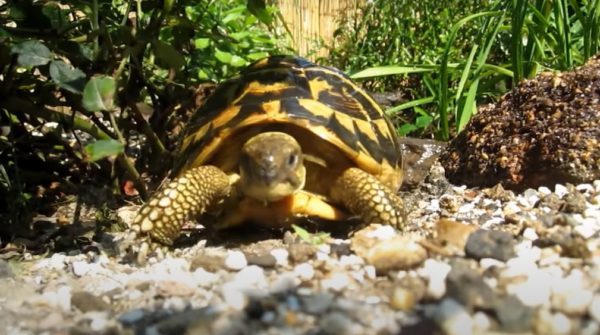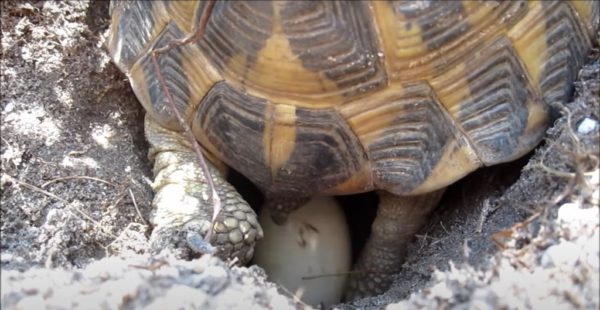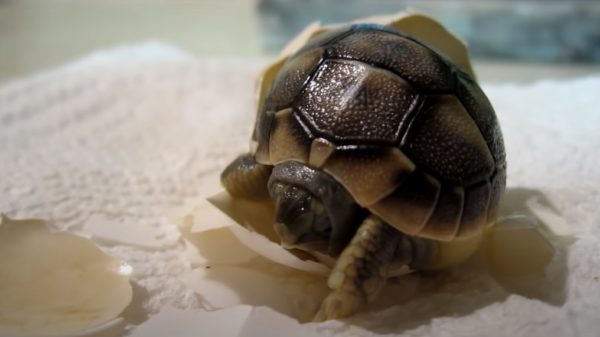You might wonder how to determine whether a turtle is pregnant because they have hard shells that cover most of their bodies. The truth is that it’s far more difficult to tell if a turtle is pregnant because the eggs are hidden beneath the shell. That said, it’s pretty easy to check if your turtle has eggs using my simple procedure. If you search for visual and behavioral changes, you can readily detect if a turtle is pregnant. The eggs on a pregnant turtle’s plastron will cause tiny lumps. A pregnant turtle will also exhibit behavioral changes. Look out for dietary changes, sunbathing behaviors, and attempts to escape the tank.
To know more about how to take care of Turtles, click here: How to take care of a turtle.
Table of Contents
How to check if your turtle is pregnant? [Best Way]
Carefully pick up the turtle and hold her for a while. Apply light to moderate pressure to the soft areas in the center of the carapace and plastron that surround the rear eggs. If she is pregnant, you may feel the ends and sides of the eggs.
How to tell if your turtle is pregnant?
Physical Changes in Pregnant turtles
The severity of physical indicators differs from turtle to turtle. You can lightly touch the lower half of the carapace, where small bumps can be found. The spots on the ground are eggs. Some owners claim that the insides of their turtles’ arms and legs turn white. However, this isn’t true for all turtles. Because turtles loathe being handled, attempting to feel the carapace is difficult. Pick up the turtle gently and hold her for a while to check yourself. Feel the soft patches around the rear eggs—in the middle of the carapace and plastron—with little to no pressure. You will feel the ends and sides of the eggs if she is pregnant.
However, if you don’t behave yourself, you can destroy the fragile eggs inside the belly and endanger the mother turtle’s life.
As a result, if you’re not sure about it, don’t go ahead and try it. Instead, visit a veterinarian.
Behavioral Changes in Pregnant Turtles

Turtles go through distinct behavioral changes that can be difficult to decipher. Aggression and tension, for example, are common mood swings. Her appetite changes, and she’ll want to sunbathe for longer than usual. She’ll try to dig for nesting in the rocks and sand once more.
Stress is a regular occurrence in all species during pregnancy. Turtles are no exception. Physical pain, tank mates, poor nutrition, and a lack of nesting space are all sources of stress during pregnancy. If there are tank mates, this mood can turn into anger, resulting in uninvited conflicts in the tank. You might also get lucky if you handle your turtle during this period. If you hold your turtle during this time, you can get bitten as well.
A pregnant turtle will also prefer to spend more time in the sun. As a result, she’ll spend more time in the sun or beneath a lamp every day to keep her body warm. Some may go many days without bathing to find a suitable nesting site.
The turtle will want to eat a lot in the early stages of pregnancy. Because she will require more energy to adjust to new body changes, this is the case. As she grows physically fatigued, her appetite will begin to wane toward the conclusion of the pregnancy.
In addition, she spends a great deal of time looking for a nesting site. This will divert her attention away from her dietary requirements. Some turtles overeat when they’re pregnant, but this is a rare occurrence.
A turtle will go to any extent to dig holes in search of the ideal nesting zone. Attempt to climb over the glass and swim through it. This is a common occurrence, but it can also be frustrating. In your capacity as a property owner, you should assist in creating an adequate nesting zone as much as feasible.
There are several additional facts to be aware of now that you know how to identify if a turtle is pregnant.
What to do if your Turtle needs to lay eggs?

You may help the egg-laying process in two ways, both of which entail location and season. You can build a suitable space out of your yard if it’s warm outside. If it’s cold outside and you don’t have a yard, you’ll have to stay inside.
The outdoor method
This is the most practical and widely used method. To begin, ensure that the yard is safe so that the turtle does not escape and roam. If this isn’t an option, you can lock a section of your yard and keep your turtle there. Wet grounds are preferred by turtles. A quick way to speed up the process is to wet the ground before letting her out. It’s worth noting, though, that the floor is free of pesticides and insecticides. If that’s the case, it’ll be disastrous.
The outdoors is excellent because it is similar to what turtles encounter in the wild. So, you don’t have to worry about cleaning up after them.
The indoor method
You’ll need at least three items for the indoor method. You will need a substantial plastic container, sand, and organic potting soil.
Fill about two-thirds of the container with a combination of equal parts sand and organic potting soil. A large container is required. Otherwise, the turtle will feel imprisoned and delay laying eggs. Again, avoid ground that includes pesticides or fertilizers, as these are harmful to turtles. After placing the mixture in the container, sprinkle the soil with water until it’s damp. After that, cover the container partially with a lid. In this manner, the turtle will be able to lay eggs in both bright and dark environments.
Make sure the temperature in the container isn’t too hot or too chilly before placing the turtle inside. You must also ensure that the setting is free of distractions. You’ll have to wait at least 2-3 hours after transferring the turtle into the container for the entire process to be completed. At this stage, don’t look at her or communicate with her. This may intimidate her and cause the laying process to be delayed.
The procedure takes about 2-3 hours, but there’s no way of knowing what the turtle will give birth to. Hence, your best option is to keep the turtle’s container in a well-lit and well-ventilated place. Some turtles prefer to lay their eggs in the morning, while others prefer to lay their eggs at night.
How to incubate Turtle eggs?

Many hobbyists like artificially incubating their turtle’s eggs. Some broad recommendations and simple strategies for practical incubation are listed below.
Depending on the species, turtle and tortoise eggs might have a hard shell or a softshell. Newly laid turtle and tortoise eggs are bluish-white. Many species’ eggs may “chalk over” in 2 days, meaning the shell will become more opaque, chalky, and white. Some water turtle and semi-terrestrial species’ eggs will chalk over the middle third or so of an elongated egg.
Candles can be used to track the development of turtle and tortoise eggs during incubation. In front of a pencil light or any other limited source of light, place the egg. On the bottom of the egg, the yolk can be seen resting. A network of blood arteries can be visible above it over time.The species of turtle and the temperature at which the eggs are incubated impact how long it takes for the eggs to hatch. Not all of the eggs may hatch at the same time. So leave any unhatched eggs to incubate for a bit longer, just in case.
The procedure takes about 2-3 hours, but there’s no way of knowing what the turtle will give birth to. Hence, your best option is to keep the turtle’s container in a well-lit and well-ventilated place. Some turtles prefer to lay their eggs in the morning, while others prefer to lay their eggs at night.
Low Humidity Methods
The following procedures can be used to incubate eggs from tortoises successfully:
- Incubators for bird eggs are popular and widely available. They can maintain a steady temperature throughout incubation because they feature a thermostat.
- You can also incubate eggs in straightforward setups like the ones below, but you must regularly monitor the temperature.
- Place the eggs in an egg carton that will be kept in an aquarium. Alternatively, fill the aquarium to a depth of 2 inches with clean sand and put the eggs in the sand. Fill the aquarium with a cup of water to act as a humidifier. Monitor the temperature using a thermometer placed near the eggs. Start with a 15-watt aquarium light in the hood as a heat source; add two bulbs or a higher-wattage bulb if it’s too chilly.
- Place the eggs in a sand bucket and bury them just beneath the surface. Place a thermometer. Place the goose-neck lamp near the bucket and move it close to the sand surface. By moving the bulb closer or farther away from the sand, you may change the temperature of the sand.
High humidity methods
Incubation of box and water turtle eggs can be done in a variety of methods. However, there are a few basic guidelines to follow:
- Do not turn, shake, or rotate the eggs.
- Temperature of 80 degrees Fahrenheit must be maintained. (27 degrees Celsius).
- Keep the humidity level at around 80 per cent.
- Place the eggs in a suitable container on a suitable substrate to meet these parameters. The container is kept warm in an incubator, a cabinet on top of a refrigerator, or above a water heater.
- Inspect the eggs daily to ensure that the substrate is still wet.
How long do turtle eggs take to hatch?
Depending on the turtle species, the time it takes for a newly laid turtle egg to hatch varies. On average, the eggs of various land and sea turtle species can take 45-90 days or 2-4 months to hatch. Nest temperature, external temperature, rainfall, humidity, incubation period, and location all affect this time frame. The hatching times for some common turtle and tortoise species are listed below.
How many eggs do sea turtles lay at once?
The number of eggs or the clutch size in a nest, varies by species. Sea turtles lay 110 eggs on average each nest and have 2 to 8 nests per season. Flatback turtles lay the smallest clutches, averaging 50 eggs each clutch. Hawksbills lay the most oversized clutches, with around 200 eggs in a single nest. Green and hawksbill turtles are primarily breeding in the Maldives. Green turtles lay 110 eggs on average per nest. The largest clutches ever reported reached 238 eggs! According to our research, the average clutch size is 82-174 eggs.
Can a female turtle have eggs by itself?
Without a male turtle to fertilise the eggs, female turtles can lay them. These infertile eggs will not hatch. In reaction to temperature and light cycle changes, many wild turtles lay eggs in the spring. This is why we see so many turtles on the roads when the weather warms up. They’re looking for sandy or soft soil to dig up and bury their eggs in. Pet turtles don’t have to follow these seasonal guidelines. This is because their habitats don’t change much, and they can lay eggs all year.
FAQ
Temperature affects the rate of development inside the eggs. Higher temperatures hasten development and more excellent conditions. As a result, the incubation period varies. Incubation lasts between 45 and 75 days for the majority of turtles.
Yes, with proper incubation methods and care, Pet turtles can also have babies.
The answer is that calcium is provided by the shell, whereas the egg includes protein. It may come as a surprise to watch your turtle consume her eggs, but it is a fantastic source of nourishment! Your female turtle’s eggs will be sterile if there are no male turtles in her surroundings. They will never hatch, in other words. It’s a typical occurrence for your pet to ingest these eggs. This is an excellent supply of calcium and protein. If you find your pet turtle eating her eggs, it could catch you off guard, but don’t be concerned.
Conclusion
To avoid this, make sure the turtle has all of the necessary conditions to lay her eggs. The lack of a suitable site to deposit the eggs is the most common cause of egg binding.
As turtle caretakers, it is your responsibility to keep an eye on the turtle. You need to identify if it is pregnant. If yes, provide a laying spot that closely resembles a natural oviposition site.
Also read: Do Turtle Sleeps a Lot?
